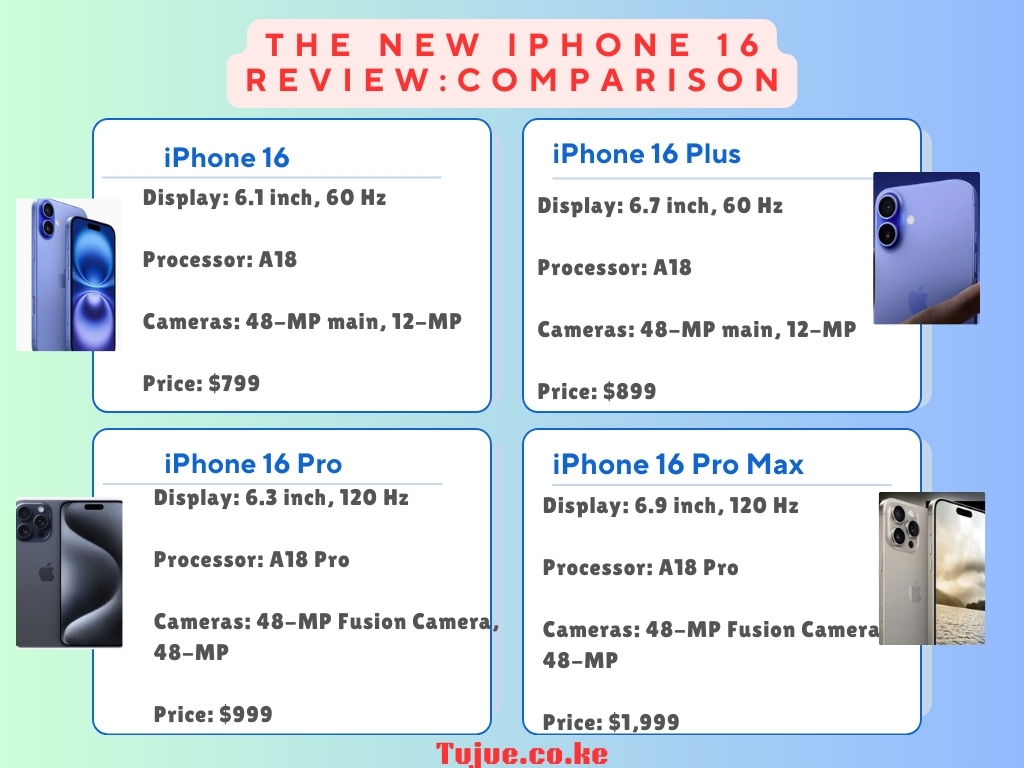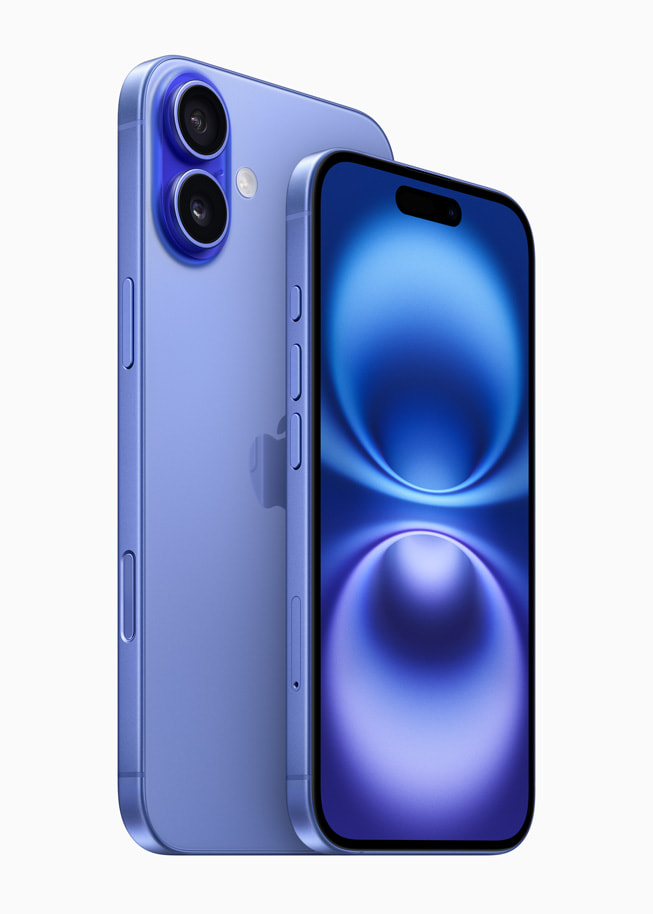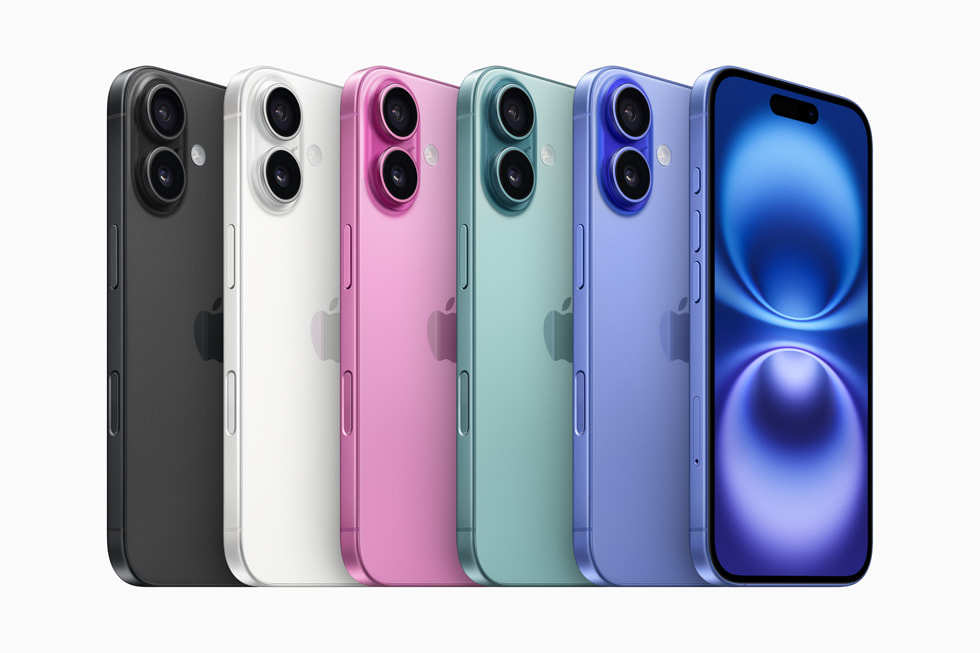The New iPhone 16 series is here…Yah!.
It comes with four models: iPhone 16, iPhone 16 Plus, iPhone 16 Pro, and iPhone 16 Pro Max. Needless to say, they all pack amazing features and state-of-the-art technology.
These latest flagship devices by apple boast improved cameras, faster processors, and enhanced AI capabilities that promise to revolutionize the way we interact with our mobile devices.
In this review, we’ll look at the features, specifications, and pricing of each model, helping you decide which iPhone 16 is the perfect fit for your needs and budget.
Quick Facts About iPhone Series
Apple unveiled the iPhone 16 series on September 9, 2024, with four models:

The New iPhone 16 Review Features, Specs and Prices Infographic
iPhone 16 and iPhone 16 Plus Specifications
| Specs | iPhone 16 | iPhone 16 Plus |
|---|---|---|
| Display: | 6.1 inch, 60 Hz, OLED, 2,000 nits | 6.7 inch, 60 Hz, OLED, 2,000 nits |
| Processor: | A18 | A18 |
| Storage: | 128 GB | 128 GB |
| Cameras: | 48-MP main camera, 12-MP ultrawide with Macro | 48-MP main camera, 12-MP ultrawide with Macro |
| Colors: | Pink, Teal, Ultramarine, White, and Black | Pink, Teal, Ultramarine, White, and Black |
| Material: | Aluminum | Aluminum |
| Price: | $799 | $899 |
iPhone 16 Pro and iPhone 16 Pro Max Specifications
| Specs | iPhone 16 Pro | iPhone 16 Pro Max |
|---|---|---|
| Display: | 6.3 inch, 120 Hz (ProMotion), OLED | 6.9 inch, 120 Hz (ProMotion), OLED |
| Processor: | A18 Pro | A18 Pro |
| Storage: | 128 GB | 256 GB |
| Cameras: | 48-MP Fusion Camera, 48-MP utrawide with Macro, 12-MP telephoto with 5X zoom | 48-MP Fusion Camera, 48-MP utrawide with Macro, 12-MP telephoto with 5X zoom |
| Colors: | Black, White, Natural, Desert | Black, White, Natural, Desert |
| Material: | Titanium | Titanium |
| Price: | $999 | $1,199 |
Key updates across the lineup:
– Processor upgrades (A18 and A18 Pro)
-Introduction of touch-sensitive “camera control”
– Increased display sizes for Pro models
– Improved camera technology in Pro models
Camera
The base iPhone 16 and 16 Plus models maintain the 48MP main and 12MP ultrawide camera setup from their predecessors, ensuring consistency for users upgrading from recent models.
However, Apple hasn’t rested on its laurels. The ultrawide camera now boasts autofocus capabilities, opening up new creative possibilities, including macro photography. This upgrade, combined with enhanced light-gathering abilities, promises to deliver superior low-light performance, addressing a common pain point in smartphone photography.
In a nod to the future of media consumption, these models now support Spatial Video and Photo capture, designed to work seamlessly with Apple’s Vision Pro headset. Audio recording has also seen improvements, with better noise reduction technology to ensure cleaner sound in video captures.
The Pro models, as expected, take things a step further. Both the iPhone 16 Pro and Pro Max now feature a 5x optical zoom, up from the 3x zoom in the iPhone 15 Pro, bringing them to parity in telephoto capabilities.
Performance
The iPhone 16 lineup features the latest A18 chip family across all models. This bifurcated approach sees the base iPhone 16 and 16 Plus models equipped with the standard A18 chip, while the Pro variants boast the more powerful A18 Pro, catering to users with more demanding needs.
Apple’s senior vice president of Worldwide Marketing Greg Joswiak had the following to say:
“Powered by the faster, more efficient A18 Pro chip and built for Apple Intelligence, iPhone 16 Pro and iPhone 16 Pro Max are the most advanced iPhone models we’ve ever made.”
The standard A18 chip in the base models is no slouch, offering impressive performance gains over its predecessors. Apple claims up to a 30% speed increase compared to the iPhone 15’s A16 chip, and an even more substantial 60% boost over the A14 Bionic found in the iPhone 12 series.
Gamers and graphics-intensive app users will appreciate the 40% improvement in GPU performance, promising smoother frame rates and more detailed visuals in mobile games and augmented reality applications.
For power users, the A18 Pro chip in the iPhone 16 Pro and Pro Max models takes things to another level. With a focus on artificial intelligence and machine learning tasks, Apple touts a 15% faster AI processing capability compared to the previous A17 Pro.
This enhancement could translate to more efficient on-device AI operations, from improved computational photography to smoother natural language processing.
AI, or ‘Apple Intelligence’
At the heart of Apple Intelligence is a range of productivity-enhancing tools. A standout feature is the ability to transform shorthand notes into fully-formed messages or documents, streamlining the writing process.
Creative expression gets a boost with AI-generated emojis, allowing users to describe their desired emoji and have the system create it.
According to a Professor of Entrepreneurship and Digital Transformation at Sheffield Business School, Dr Seun Kolade:
“Apple Intelligence, the new iteration of the company’s continued investment in AI and machine learning, raises the bar for industry competitors who must now innovate or risk falling behind in a fast-paced AI race. Apple is able to take a significant leap forward in its competitive advantage by integrating AI across its entire product ecosystem for better and more exciting user experience with enhanced AI-driven features like predictive texts, health monitoring, and personalised recommendations, among others.”
For the visually inclined, the new Image Playground app harnesses the power of generative AI, enabling users to create images from text prompts, similar to popular AI art generators.
Photo management sees significant improvements, with the ability to search for images using natural language descriptions. This feature extends to automatically arranging matching photos into albums or storylines, making it easier than ever to organize and relive memories.
Perhaps most excitingly, Siri, Apple’s virtual assistant, is set for a major upgrade. The assistant will also become more context-aware, recognizing on-screen content and acting upon it. For instance, if a song name appears in a message, users can simply ask Siri to “play that,” streamlining the music playback process.
Battery Life
| Activity | iPhone 16 | iPhone 16 Plus | iPhone 16 Pro |
|---|---|---|---|
| Video Playback | 22 hours | 27 hours | 27 hours |
| Video Playback (Streamed) | 18 hours | 24 hours | 22 hours |
| Audio Playback | 80 hours | 100 hours | 85 hours |
Apple has made significant strides in extending the battery life of the iPhone 16 series, addressing one of the most crucial aspects of smartphone usability. The base iPhone 16 models boast what Apple describes as a “big boost in battery life.”
To put this into perspective, the company’s specifications indicate that the standard iPhone 16 can now achieve 22 hours of video playback, a notable improvement over the iPhone 15’s 20-hour capability.
The crown jewel in terms of power endurance is the iPhone 16 Pro Max, which Apple boldly claims offers the “best iPhone battery life ever.”
According to the company’s specifications, this top-tier model can sustain an impressive 33 hours of video playback, a substantial increase from the iPhone 15 Pro Max’s 29-hour capacity.
This enhancement in battery performance across all four models of the iPhone 16 series is attributed to a combination of factors: larger battery capacities, improved energy efficiency from the new iOS 18 operating system, and the optimized power management of the A18 and A18 Pro processors.
Design

The base iPhone 16 models introduce a refreshed camera layout, featuring an oval design with vertically aligned lenses. This arrangement harkens back to the iconic look of the iPhone X and XS series, blending familiarity with modernity.
In contrast, the Pro models maintain their distinctive three-camera array, providing visual continuity for users upgrading from the previous generation.
Apple has pushed the boundaries of display technology with the Pro models, boasting what they claim are the thinnest borders “on any product” in their lineup.
This achievement in minimizing bezels comes with a slight trade-off in size and weight, with the iPhone 16 Pro models being marginally larger and heavier than their predecessors.
Material choices continue to differentiate the base and Pro models. The standard iPhone 16 and 16 Plus retain their durable aluminum frames, offering a balance of strength and lightness. The Pro models, following the precedent set by the iPhone 15 Pro, feature premium titanium frames.

Across all four models, Apple has maintained the softer, more comfortable contoured edges introduced with the iPhone 15 generation, enhancing ergonomics and grip.
Color options for the new lineup cater to a variety of tastes. The base models introduce a vibrant palette including:
– Ultramarine (a striking blue hue)
– Teal
– Pink
– White
– Black.
For those preferring a more subdued aesthetic, the Pro models offer a sophisticated range of Black, White, Natural, and Desert Titanium finishes.
New Buttons

The iPhone 16 series introduces significant changes to the device’s physical interface, with the new Camera Control button taking center stage across all models.
This innovative button is a tactile switch that incorporates haptic feedback, responding to various combinations of presses, taps, and swipes to enable a multitude of functions.
On all iPhone 16 models, the Camera Control button serves as a quick access point to photography features. A simple press opens the camera app, with a subsequent press capturing a photo.
For video enthusiasts, pressing and holding the button initiates video recording. The button’s touch-sensitive nature allows for nuanced control within the camera app – a light touch reveals zoom controls, while a double light touch brings up finer adjustments like depth of field and exposure settings.
iPhone 16 price: How Much Will the iPhone 16 Cost?
| Model | Starting Price (USD) | Starting Price (GBP) |
|---|---|---|
| iPhone 16 | $799 | £799 |
| iPhone 16 Plus | $899 | £899 |
| iPhone 16 Pro | $999 | £999 |
| iPhone 16 Pro Max | $1,199 | £1,199 |
Apple has revealed the pricing structure for its latest smartphone lineup, with costs varying across models and regions:
– The standard iPhone 16 starts at $799 or £799
– For those preferring a larger screen, the iPhone 16 Plus begins at $899 or £899
– Stepping into the Pro territory, the iPhone 16 Pro is priced from $999 or £999
– The top-tier iPhone 16 Pro Max commands a premium, starting at $1,199 or £1,199
It’s worth noting that these prices come with a caveat in the United States. Opting for an unlocked device – one that isn’t tied to a specific carrier – will set you back a bit more.
iPhone 16 Price in Kenya
The iPhone 16, Apple’s latest flagship smartphone, is expected to be available in Kenya with prices ranging from KSh 127,500 to KSh 207,000 (sometimes slightly more based on the dollar rate).This price range likely reflects different storage capacities and model variants within the iPhone 16 lineup.
Note: As with previous iPhone releases, the actual prices may vary depending on the specific retailer, any ongoing promotions, and potential fluctuations in currency exchange rates.
Should You Buy an iPhone 16?
As with most annual iPhone releases, the most noticeable improvements tend to be more pronounced for users upgrading from older models. If you’re currently using an iPhone 15, for instance, the jump to an iPhone 16 might not present a drastically different experience in terms of core functionality and performance.
However, the introduction of Apple’s new AI features, branded as Apple Intelligence, adds a new dimension to the upgrade consideration. This suite of AI-powered capabilities promises to enhance various aspects of the iPhone experience, from productivity tools to creative applications.
For users eager to explore these cutting-edge features, the iPhone 16 series presents an attractive proposition. It’s worth noting, though, that owners of iPhone 15 Pro models don’t need to upgrade solely for access to these AI features, as Apple has extended support to these previous-generation devices.

